“Loving Island Life” Article By Avatar Singh

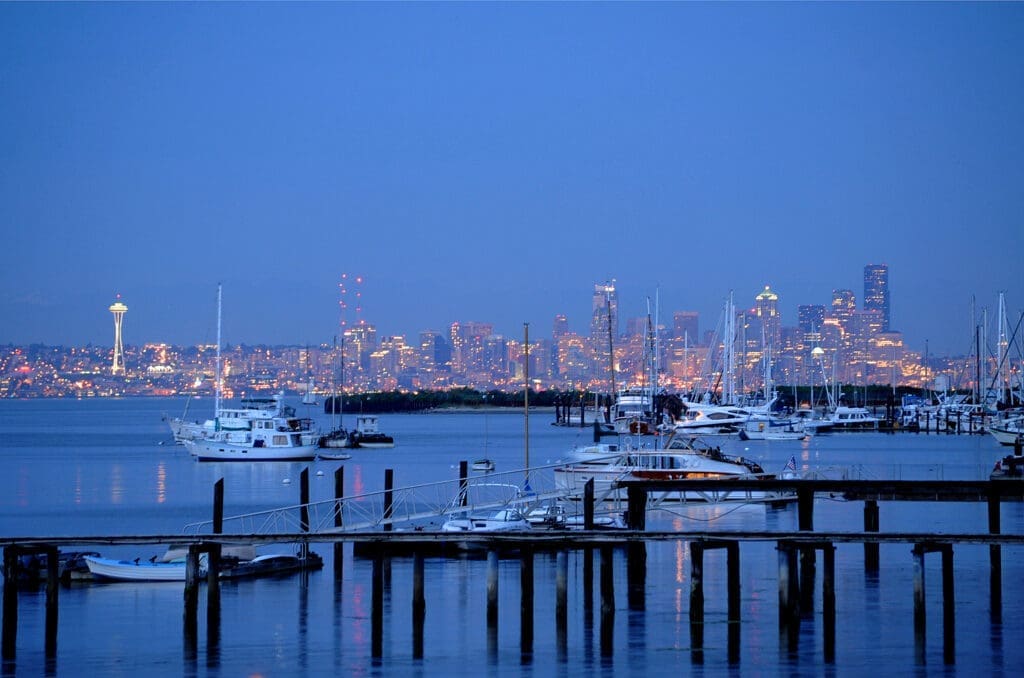
Terrific article by Avatar Singh…
Seattle is a jewel of a city in the northwest corner of the United States. Which means that it’s frequently cold, mostly wet and always far away. But if you can muster the energy to get there, it’s a terrific place. Take my word for it. I’ve been a fan for almost twenty years.
I’d been there for college conferences, back when the world was young and Kurt Cobain’s passing was still recent enough that men in plaid shirts and ragged shorts knocked about the streets cultivating misery. I returned to welcome a new year there, amidst yacht rides on Puget Sound and midnight revelries in outdoor hot tubs, a pointer to how, while still chilly, the city maintained a temperate even keel due to the warming current that ran through the Pacific Ocean. I was in Canada’s armpit in high winter that year and I didn’t see a single fleck of snow. I remember curious open faces in bars and a pedestrian- and cycle-friendly city and a liberal forward-looking populace. The coffee was good and the micro-brewed beer available everywhere even better and the dominant aesthetic seemed charged with the flavours, sights and smells of the Pacific Rim. There was a youthful energy to the city that was infectious. So, sixteen years after my last visit, I jumped at the chance to go back.
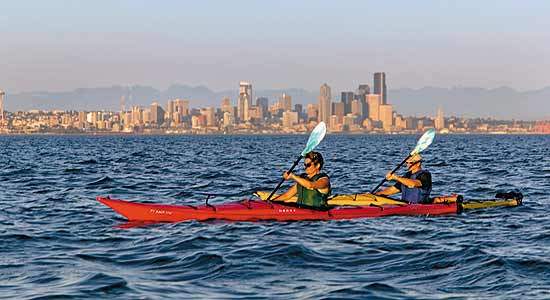
Kayaking off Bainbridge Island
Naturally, it snowed.
Seattle isn’t used to snow, due to the aforementioned warm current. In fact, when it does snow, the city retreats with a baffled expression behind a rampart of freshly brewed coffee. This time, however, it snowed with such severity that the airport closed for the next two days after we landed. It was so cold that the snow turned to ice and then ice actually fell from the sky. It was so icy that trees, under the weight of the frozen precipitation, fell on electric lines and parts of the surrounding areas were plunged into darkness. For two days, a quarter of a million people had no electricity. It was so cold, in fact, that Seattle became like India.
Well, not quite. But you know.
The city of Microsoft and Boeing and Amazon and Starbucks ground, literally, to a halt. I didn’t mind. What’s a wet butt garnered from an involuntary slide down one of Seattle’s plentiful hills, when measured against having a whole city to oneself? Especially when it is in winter wonderland mode. Some of the streets still wore their Christmas and New Year’s decorations. The effect, against the ice on the ground and the drifting snow, was magical.
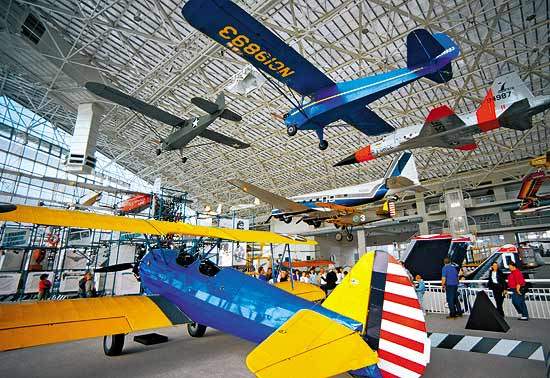
The Museum of Flight
It so happened that we were staying downtown. Seattle, in contrast to many American cities, has managed to keep its city centre vibrant. Hotels and restaurants share space with people’s homes, and the chilly quiet that descends on many commuter cities after sundown is absent here. Even at the height of the storm, there were people out and about in the city itself. A few blocks down the road from our hotel lay Pike Place Market, almost as ubiquitous a marker of Seattle as the Space Needle or politically correct techies. This old place has weathered many storms, and the vendors who are its beating heart acknowledge and indeed revel in their place in the popular imagination. The men at the corner fish stall, ‘World Famous’ Pike Place Fish, right behind the patron pig of the market—her name is Rachel—will mock-grumpily accede to your wish to see them throw the fish from the basket to the weighing counter. One of our party, a vegetarian Gujarati, volunteered to catch the dead beast. He pulled off a perfect grab. If only the Indian cricket team, then immersed in acquiring its own wintry wash in summery Oz, had been watching.
Just a short ferry ride across the Sound, Bainbridge Island is the perfect place to ‘get away’ to, if the big city’s wearing you down…..
Elsewhere in the market are crafts stores, cafés and buzzy eateries and men and women vending their goods from barrows. There are cherries from local Washington orchards, delicious cured salmon jerky, beers in dark holes with fabulous views, and enough local flavour to sate any tourist’s palate. Yet the history of the place is, if anything, more interesting, and is in many ways a microcosm both of the Pacific Northwest and the United States itself. Seattle—named for a Native American chief who apparently didn’t want to be so honoured—was a booming lumber town at the turn of the twentieth century. A few entrepreneurial souls had sewn up the wholesale vegetable trade and drove prices up as and when they chose. In the first decade of the new century, a few hardy traders showed up at Pike Place to sell their goods directly to the townsfolk, defying threats and physical violence. The market’s been there, independence written into its charter, ever since, weathering fires, booms, busts and everything in between.
It’s a lovely story, but if you dig a bit, skeletons do tumble out. The internment of Japanese American citizens during WWII cleared the Japanese vendors out of the market. To my admittedly impressionist eye, they don’t seem to have returned in any major way (though Pike Place Fish is an exception). In a city turned so resolutely to its Pacific side, it seems a little odd. But in many other ways, Seattle is the model of the progressive American city.
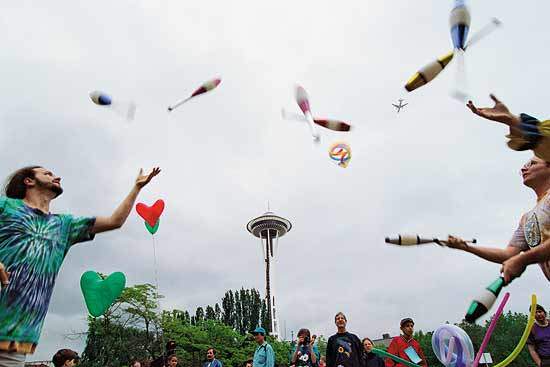
A view of Seattle’s Space Needle
The World’s Fair of 1962 gave a new sense of purpose to the city, and its enduring symbol, the Space Needle. This Needle has fantastic views, a good—though pricey—restaurant, and apparently long lines in summer. The panoramas to be had would justify those waits, I think, as you can see for miles in any direction. Hold on to your hats when outside, though; it gets windy. Since this is the 50th anniversary of that historic occasion, Seattle’s getting gussied up. The Seattle Centre and the Space Needle are collaborating on a variety of events, including art shows, performances, food festivals and the like. But for even the casual visitor, the World’s Fair has a significance beyond that of what you and the tots can expect this summer.
The lead-up to the fair of 1962 and the roughly coeval rise of the University of Washington as a first-class institution of learning led, in some accounts, to Seattle discovering itself as a centre of the knowledge economy to come. The city’s main industrial driver before that had been Boeing, and the trials and triumphs of that aviation behemoth had been reflected in the fortunes of the city. Within two decades of the fair, Seattle entered a new phase with Microsoft and its tributary companies, and found itself invaded by that bearded new species, the tech professional.
Seattle, even when the snow is still packed on the ground, knows how to party. fans of the nightlife won’t be disappointed here…….
A visit to the Microsoft campus in Bellevue isn’t easy for a casual tourist, but if you make the effort, it’s quite something. We visited both the ‘home’ and ‘office of the future’, purpose-designed and -built installations that point toward where these eggheaded folk think the human race is headed with the tech doodads at hand. Walls that function as screens, information on visitors to your home showing up on your phone, programs that monitor whether your mother’s sleeping soundly: fascinating to many people, if not to me. Well, that isn’t completely true. I was rather taken with one functional view of a desktop of the future, where icons and all relevant information including mails are grouped by task, and not by program and file, as they are currently. I’d love an operating system that so closely mirrors the way my actual desk in the real world is arranged. But, given the way my interests actually arrange myself, I was far more charged up by a visit to that other Seattle institution.
Yes. Boeing. Let the coders and their offspring queue up outside Microsoft. I like planes.
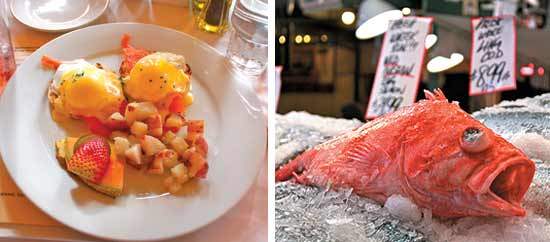
Brunch at Cafe Nola on Bainbridge Island; catch of the day at Pike Place Market. (Photograph by Sonia Nazareth)
Boeing Field is home to the flight-testing of the 737 and houses the Museum of Flight. We got to visit the Mukilteo facility, which is home to the 747, 767, 777 and the new 787 Dreamliner assembly lines, and the Future of Flight museum. This enormous facility was at one time the single largest building in the world. It may not be, anymore. But it’s big enough to see four 747s in, at one time. And that’s only one line. A little further, you see 767s getting worked on. And then 777s. And then the new 787s. Under one roof.
It’s not a shack. And there isn’t a photo in the world that can do it justice.
When we were there, new planes already wearing the liveries of the airlines they’re getting delivered to were undergoing final flight testing. Immense planes took off and landed on that gigantic white carpet as we watched. The snow drifted in, as did jet planes. If you’ve ever dreamt of wearing a pair of wings on your breast, you’ll want to go here.
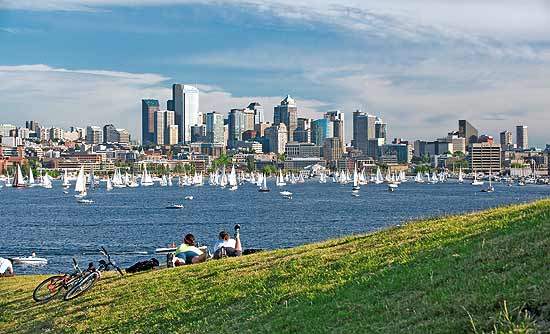
The Seattle skyline and Lake Union
To mark the 50th anniversary of the world’s fair, Seattle’s getting gussied up. On offer are art shows, food festivals, and the like…..
Back in the city, or more precisely, across the Sound from it, is Bainbridge Island. A short ferry ride away, this is the perfect place to ‘get away’ to, if the big city’s wearing you down. Winslow is the little town closest to where the ferry docks; it’s also the main drag of Bainbridge. Boat-mad Seattle types flock to the marina. Other activities include kayaking, cycling and scuba diving. Miles of walking and jogging and a blessed shortage of vehicular traffic make this a tranquil spot in winter as well. Winslow itself makes for a superb afternoon’s wandering about. Restaurants that range from tony cafés to diners, independent bookstores and stores selling expensively tasteful stuff you really don’t need: think of it as a West Coast Cape Cod. Naturally, all this charm doesn’t come cheap. But if you’re looking for a romantic spot, Bainbridge Island has the rooms for you. On the way back to the city, the ferry will deliver some outstanding views of Seattle’s legendary skyline.
But you won’t just be sightseeing. Seattle’s famous for its almost religious devotion to its local seafood-heavy, Pacific Rim-influenced cuisine. Ingredients are locally-sourced, meals are slow-cooked, even the wine is brought across from within Washington itself (there is a drier part of this state with actual seasons). The wine, well, it gets better the more you drink. The food, unreservedly, is superb. Crab cakes, scallops, fish of any sort and in any preparation; the list goes on.
Additionally, the international, well-travelled and -heeled and generally well-educated populace of Seattle and its satellite towns means that you have a full range of dining options on offer, from dal to dim sum. An old friend and Singapore standby, Din Tai Fung dumpling house, salvaged our lunch hour one snowy day in Bellevue.
I’m also relieved to report that the coffee and beer is still worth researching. Old friends like Full Sail and Red Hook are still being poured, while new acquaintances fizzed and bubbled around us. Starbucks is everywhere, but Seattle’s fascination with the dark bean goes well beyond that multinational’s cut-piece storefronts. And Seattle, even when the snow is still packed on the ground, knows how to party. Fans of the nightlife won’t be disappointed here.
So, you see, there really isn’t any excuse. There aren’t too many places left like Seattle in the world, places with big-city pretensions but a cosy, ‘we’re all neighbours’ vibe. Go and take a look. It’s worth it!
